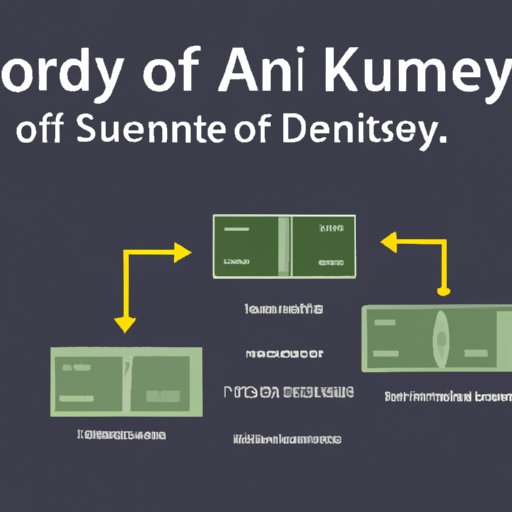Introduction
Money orders are a popular form of payment that are often used for transactions that require a more secure method than cash or checks. However, some people may not be familiar with what money orders look like and how to identify them. Understanding the physical characteristics and security features of a money order is crucial to prevent fraud and errors during financial transactions.
All You Need to Know About Money Orders: A Comprehensive Guide to Identifying Them
Money orders are a form of prepaid payment where the issuer guarantees payment up to a certain amount. They can be purchased at post offices, banks, and retail stores. Money orders are often used by people who do not have access to a bank account, need to make a payment that requires a guaranteed form of payment or need to send money to another person without revealing their bank account information. Unlike personal checks, money orders are prepaid and therefore cannot be returned for insufficient funds.
Visual Guide: Understanding the Appearance of a Money Order
Money orders vary in appearance depending on the issuer, but there are some common features. They are typically the same size as a check or a little bit larger, and are often pink, yellow, or green. Money orders issued by the US Postal Service feature an eagle watermark, while Western Union money orders feature a padlock watermark. Money orders also have a perforated edge, which can be detached and used as a receipt. Most money orders cost a few dollars to purchase, and have a maximum value limit of around $1,000.
What Does a Money Order Look Like? A Step-by-Step Breakdown of Its Features
Each money order will differ slightly, so it’s important to pay attention to specific security features. Below is a list of common characteristics found in most money orders:
1. Payee and Payer Information
The payee field on a money order is where the recipient’s name is written. The payer field is where the purchaser’s information is written. Unlike personal checks, money orders do not reveal bank account information, providing greater privacy for both parties.
2. Dollar Amount
The dollar amount of the transaction is written in both numerical and written format to avoid confusion about the amount of money being transferred.
3. Serial Number
Each money order has a unique serial number on it, which is used to track the transaction. This number is often printed in a unique font to prevent fraud.
4. Signature
The purchaser of the money order must sign the document when they purchase it. This signature helps verify that the person purchasing the money order is responsible for the payment.
Why Recognizing a Money Order Is Important: A Close Look at Its Design
Money orders have several security features in place to prevent fraud. Understanding these features is important to ensure a legitimate transaction. Common security features include:
1. Watermarks
Watermarks are slightly visible designs within the paper that are difficult to copy. These designs are created during the paper-making process.
2. Security Thread
A security thread is embedded in the paper of a money order. This thread is visible under ultraviolet light and reveals a unique pattern to confirm authenticity.
3. Microprint
Microprint is a small typeface that is difficult to reproduce. This typeface is often used for the dollar amount and border of a money order.

The Anatomy of a Money Order: Understanding Its Layout and Security Features
Knowing how to correctly fill out a money order is crucial to ensure that it is valid. Here are the main elements to look for:
1. Payee and Payer Information
Make sure that the information in the payee and payer field is complete and legible. Incorrect information can cause the transaction to be declined or delayed.
2. Correct Amount
Double-check the amount to make sure it matches the agreed transaction amount.
3. Legitimate Serial Number
Make sure that the serial number on the document is visible and matches the serial number on your receipt.
Simplifying the Mystery: How to Recognize a Money Order with Ease
Here are some helpful tips to quickly identify a money order:
1. Perforated Edges
Money orders have a perforated edge that serves as a receipt. Make sure to keep the receipt for your records to prevent any future errors or problems.
2. Watermarks and Security Features
Look for the unique watermarks and security features that vary depending on the issuer. These features provide additional security and ensure the legitimacy of the document.
3. Serial Numbers
Make sure the serial number on the money order matches the serial number on the receipt to ensure the transaction can be tracked properly.
Never Mistake a Money Order Again: Understanding What They Look Like and How to Use Them
Money orders can be a reliable and secure form of payment if used correctly. Here are some final thoughts:
1. Verify Legitimacy
Always verify the legitimacy of the money order before accepting it as payment. Check for watermarks, security features, and correct information on the document.
2. Keep Your Receipt
Keep the receipt and the detachable portion of the money order for your records and verification purposes. This can be used as proof of payment in case of any future issues.
3. Read the Fine Print
Make sure to read and understand the terms and conditions of the money order issuer. This will prevent any hidden fees or restrictions on the use of the money order.
Conclusion
Money orders are a secure and reliable payment option for transactions that require a more secure form of payment. Understanding what a money order looks like and how to identify key security features is important for any financial transaction. By following these tips and guidelines, you can confidently recognize and use money orders for your financial needs.
